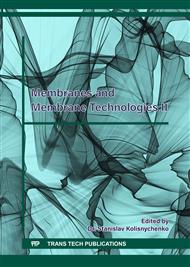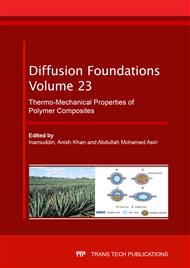[1]
W. J. Koros, R. P. Lively, Water and beyond: Expanding the spectrum of large scale energy efficient separation processes, AIChE J. 58 (2012) 2624-2633.
DOI: 10.1002/aic.13888
Google Scholar
[2]
R. W. Baker, Future Directions of Membrane Gas Separation Technology, Ind. Eng. Chem. Res. 41 (2002) 1393-1411.
DOI: 10.1021/ie0108088
Google Scholar
[3]
V. Stannett, The transport of gases in synthetic polymeric membranes-an historic perspective, J. Membr. Sci. 3 (1978) 97-115.
DOI: 10.1016/s0376-7388(00)83016-1
Google Scholar
[4]
J. A. Nollet, Investigations on the causes for the ebullition of liquids, J. Membr. Sci. 100 (1995) 1-3.
Google Scholar
[5]
S. S. Dhingra, Mixed gas transport study through polymeric membranes: A novel technique, PhD Dissertation. Virginia Polytechnic Institute and State University (1997).
Google Scholar
[6]
W. Koros, C. Zimmerman, in: R. F. Brady (Ed.), Comprehensive Desk Reference of Polymer Characterization and Analysis (Chemistry), Oxford University, 2003, pp.680-699.
Google Scholar
[7]
V. I. Bondar, B. D. Freeman, Y. P. Yampolskii, Sorption of Gases and Vapors in an Amorphous Glassy Perfluorodioxole Copolymer, Macromolecules. 32 (1999) 6163-6171.
DOI: 10.1021/ma9817222
Google Scholar
[8]
W. J. Koros, A. H. Chan, D. R. Paul, Sorption and transport of various gases in polycarbonate, J. Membr. Sci. 2 (1977) 165-190.
DOI: 10.1016/s0376-7388(00)83242-1
Google Scholar
[9]
J. S. Vrentas, C. M. Vrentas, Predictive methods for self-diffusion and mutual diffusion coefficients in polymer–solvent systems, Eur. Polymer J. 34 (1998) 797-803.
DOI: 10.1016/s0014-3057(97)00205-x
Google Scholar
[10]
B.D. Freeman, Basis of Permeability/Selectivity Tradeoff Relations in Polymeric Gas Separation Membranes, Macromolecules. 32 (1999) 375-380.
DOI: 10.1021/ma9814548
Google Scholar
[11]
L.M. Robeson, The upper bound revisited, J. Membr. Sci. 320 (2008) 390-400.
Google Scholar
[12]
W. J. Koros, M. R. Coleman, D. R. B. Walker, Controlled Permeability Polymer Membranes, Annu. Rev. Mater. Sci. 22 (1992) 47-89.
DOI: 10.1146/annurev.ms.22.080192.000403
Google Scholar
[13]
T. H. Kim, W. J. Koros, G. R. Husk, K. C. O'Brien, Relationship between gas separation properties and chemical structure in a series of aromatic polyimides, J. Membr. Sci. 37 (1988) 45-62.
DOI: 10.1016/s0376-7388(00)85068-1
Google Scholar
[14]
J. H. Kim, S. B. Lee, S. Y. Kim, Incorporation effects of fluorinated side groups into polyimide membranes on their physical and gas permeation properties, J. Appl. Polym. Sci. 77 (2000) 2756-2767.
DOI: 10.1002/1097-4628(20000919)77:12<2756::aid-app240>3.0.co;2-c
Google Scholar
[15]
M. D. Guiver, G. P. Robertson, Y. Dai, F. Bilodeau, Y. S. Kang, K. J. Lee, J. Y. Jho, J. Won, Structural characterization and gas-transport properties of brominated matrimid polyimide, J. Polym. Sci., Part A: Polym. Chem. 40 (2002) 4193-4204.
DOI: 10.1002/pola.10516
Google Scholar
[16]
M. W. Hellums, W. J. Koros, J. C. Schmidhauser, Gas separation properties of spirobiindane polycarbonate, J. Membr. Sci. 67 (1992) 75-81.
DOI: 10.1016/0376-7388(92)87041-u
Google Scholar
[17]
L. A. Pessan, W. J. Koros, J. C. Schmidhauser, W. D. Richards, Gas transport properties of polymers based on spirobiindane bisphenol, J. Polym. Sci. Part B Polym. Phys. 33 (1995) 487-494.
DOI: 10.1002/polb.1995.090330317
Google Scholar
[18]
C.M. Zimmerman, W.J. Koros, Comparison of gas transport and sorption in the ladder polymer BBL and some semi-ladder polymers, Polymer. 40 (1999) 5655-5664.
DOI: 10.1016/s0032-3861(98)00777-0
Google Scholar
[19]
P. M. Budd, B. S. Ghanem, S. Makhseed, N. B. McKeown, K. J. Msayib, C. E. Tattershall, Polymers of intrinsic microporosity (PIMs): robust, solution-processable, organic nanoporous materials, Chem. Commun. (2004) 230-231.
DOI: 10.1039/b311764b
Google Scholar
[20]
N.B. McKeown, P.M. Budd, K.J. Msayib, B.S. Ghanem, H.J. Kingston, C.E. Tattershall, S. Makhseed, K.J. Reynolds, D. Fritsch, Polymers of Intrinsic Microporosity (PIMs): Bridging the Void between Microporous and Polymeric Materials, Chem. Eur. J. 11 (2005) 2610-2620.
DOI: 10.1002/chem.200400860
Google Scholar
[21]
C.R. Mason, L. Maynard-Atem, K.W.J. Heard, B. Satilmis, P.M. Budd, K. Friess, M. Lanc, P. Bernardo, G. Clarizia, J.C. Jansen, Enhancement of CO2 Affinity in a Polymer of Intrinsic Microporosity by Amine Modification, Macromolecules. 47 (2014) 1021-1029.
DOI: 10.1021/ma401869p
Google Scholar
[22]
J. D. Goddard, J. S. Schultz and S. R. Suchdeo, Facilitated transport via carrier-mediated diffusion in membranes: part II. mathematical aspects and analyses, AlChE J. 20(4) (1974) 625-645.
DOI: 10.1002/aic.690200402
Google Scholar
[23]
J. D. Goddard, Further applications of carrier- mediated transport theory: a survey, Chem. Eng. Sci. 32 (1977) 795.
Google Scholar
[24]
K. A. Smith, J. H. Meldon and C. K. Colton, An analysis of carrier-facilitated transport, AlChE J. 19(1) (1973) 102.
Google Scholar
[25]
D. Yung and R. L. Probstein, Similarity considerations in facilitated transport, J. Phys. Chem. 77(18) (1973) 2201.
DOI: 10.1021/j100637a009
Google Scholar
[26]
E. L. Cussler, R. Aris, and A. Bhown, On the limits of facilitated diffusion, J. Membr. Sci. 43 (1989) 149-164.
DOI: 10.1016/s0376-7388(00)85094-2
Google Scholar
[27]
R. D. Noble, Analysis of facilitated transport in fixed site carrier membranes, J. Membr. Sci. 50 (1990) 207-214.
DOI: 10.1016/s0376-7388(00)80316-6
Google Scholar
[28]
N. J. Kemp and R. D. Noble, Heat transfer effects in facilitated transport liquid membranes, Sep. Sci. Technol. 18 (1983) 1147-1165.
DOI: 10.1080/01496398308059922
Google Scholar
[29]
T. Welton, Room-Temperature Ionic Liquids. Solvents for Synthesis and Catalysis, Chem. Rev. 99 (1999) 2071-2084.
DOI: 10.1021/cr980032t
Google Scholar
[30]
J. E. Bara, D. L. Gin, R. D. Noble, Effect of Anion on Gas Separation Performance of Polymer−Room-Temperature Ionic Liquid Composite Membranes, Ind. Eng. Chem. Res. 47 (2008) 9919-9924.
DOI: 10.1021/ie801019x
Google Scholar
[31]
D. Mecerreyes, Polymeric ionic liquids: Broadening the properties and applications of polyelectrolytes, Prog. Polym. Sci. 36 (2011) 1629-1648.
DOI: 10.1016/j.progpolymsci.2011.05.007
Google Scholar
[32]
X. Lin, J. Chen, J. Xu, Improvement of oxygen/nitrogen permselectivity of poly[1-(trimethylsilyl)-1-propyne] membrane by plasma polymerization, J. Membr. Sci. 90 (1994) 81-89.
DOI: 10.1016/0376-7388(94)80035-9
Google Scholar
[33]
X. Lin, X. Qiu, G. Zheng, J. Xu, Gas permeabilities of poly(trimethylsilylpropyne) membranes surface modified with CCI4 plasma, J. Appl. Polym. Sci. 58 (1995) 2137-2139.
DOI: 10.1002/app.1995.070581127
Google Scholar
[34]
H. Matsuyama, K. Hirai, M. Teramoto, Selective permeation of carbon dioxide through plasma polymerized membrane from diisopropylamine, J. Membr. Sci. 92 (1994) 257-265.
DOI: 10.1016/0376-7388(94)00069-7
Google Scholar
[35]
L. Shao, J. Samseth, M. B. Hagg, Effect of Plasma Treatment on the Gas Permeability of Poly(4 methyl-2-pentyne) Membranes, Plasma Process. Polym. 4 (2007) 823-831.
DOI: 10.1002/ppap.200600219
Google Scholar
[36]
S.L. Liu, L. Shao, M.L. Chua, C.H. Lau, H. Wang, S. Quan, Recent progress in the design of advanced PEO-containing membranes for CO2 removal, Prog. Polym. Sci. 38 (2013) 1089-1120.
DOI: 10.1016/j.progpolymsci.2013.02.002
Google Scholar
[37]
J. M. Duval, A. J. B. Kemperman, B. Folkers, M. H. V. Mulder, G. Desgrandchamps, C. A. Smolders, Preparation of zeolite filled glassy polymer membranes, J Appl Polym Sci. 54 (1994) 409-418.
DOI: 10.1002/app.1994.070540401
Google Scholar
[38]
K. I. Lee, I. W. Shim, S. T. Hwang, The effects of transition metal complexes on the permeation of small gas molecules through cellulose acetate membranes, J Membr Sci. 60 (1991) 207-218.
DOI: 10.1016/s0376-7388(00)81535-5
Google Scholar
[39]
M. Wessling, M. L. Lopez, H. Strathmann, Accelerated plasticization of thin-film composite membranes, Sep Purif Technol. 24 (2001) 223-233.
DOI: 10.1016/s1383-5866(01)00127-7
Google Scholar
[40]
A. F. Ismail, W. Lorna, Penetrant-induced plasticization phenomenon in glassy polymers for gas separation membrane, Sep Purif Technol. 27 (2002) 173-94.
DOI: 10.1016/s1383-5866(01)00211-8
Google Scholar
[41]
L. S. White, T. A. Blinka, H. A. Kloczewski, I. F. Wang, Properties of a polyimide gas separation membrane in natural gas streams, J Membr Sci. 103 (1995) 73-82.
DOI: 10.1016/0376-7388(94)00313-n
Google Scholar
[42]
H. Y. Zhao, Y. M. Cao, X. L. Ding, M. Q. Zhou, J. H. Liu, Q. Yuan, Poly(ethylene oxide) induced cross-linking modification of Matrimid membranes for selective separation of CO2. J Membr Sci. 320 (2008) 179-184.
DOI: 10.1016/j.memsci.2008.03.070
Google Scholar
[43]
A. M. W. Hillock, W. J. Koros, Cross-linkable polyimide membrane for natural gas purification and carbon dioxide plasticization reduction, Macromolecules. 40 (2007) 583-587.
DOI: 10.1021/ma062180o
Google Scholar
[44]
J. D. Wind, D. R. Paul, W. J. Koros, Natural gas permeation in polyimide membranes. J Membr Sci. 228 (2004) 227-236.
DOI: 10.1016/j.memsci.2003.10.011
Google Scholar
[45]
V. Abetz, T. Brinkmann, M. Dijkstra, K. Ebert, D. Fritsch, K. Ohlrogge, Developments in membrane research: from material via process design to industrial application, Adv Eng Mater. 8 (2006) 328-358.
DOI: 10.1002/adem.200600032
Google Scholar
[46]
I. Pinnau, L. G. Toy, Transport of organic vapors through poly(1-trimethylsilyl-1-propyne). J Membr Sci. 116 (1996) 199-209.
DOI: 10.1016/0376-7388(96)00041-5
Google Scholar
[47]
I. Pinnau, C. G. Casillas, A. Morisato, B. D. Freeman, Hydrocarbon/hydrogen mixed gas permeation in poly(1-trimethylsilyl-1-propyne) (PTMSP), poly(1-phenyl-1-propyne) (PPP), and PTMSP/PPP blends, J Polym Sci B: Polym Phys. 34 (1996) 2613-2621.
DOI: 10.1002/(sici)1099-0488(19961115)34:15<2613::aid-polb9>3.0.co;2-t
Google Scholar
[48]
K. A. Lokhandwala, I. Pinnau, Z. He, K. D. Amo, A. R. DaCosta, J. G. Wijmans, R. W. Baker, Membrane separation of nitrogen from natural gas: a case study from membrane synthesis to commercial deployment, J Membr Sci. 346 (2010) 270-279.
DOI: 10.1016/j.memsci.2009.09.046
Google Scholar
[49]
K. A. Lokhandwala, M. Ringer, J. G. Wijmans, R. W. Baker, Nitrogen removal from natural gas using membranes. National Energy Technology Laboratory, NG8-2; (1997).
Google Scholar
[50]
J. P. Agrawal, S. Sourirajan, Helium separation by cellulose acetate membranes, J Appl Polym Sci. 13 (1969) 1065-1068.
DOI: 10.1002/app.1969.070130520
Google Scholar



